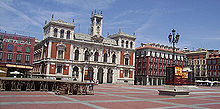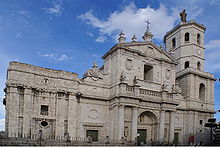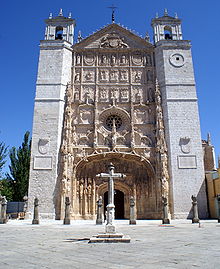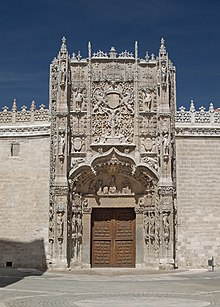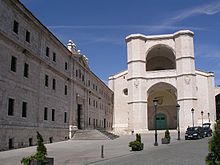Valladolid
| Valladolid municipality | ||
|---|---|---|
 Valladolid - city center with Iglesia San Pablo
|
||
| coat of arms | Map of Spain | |

|
|
|
| Basic data | ||
| Autonomous Community : | Castile and Leon | |
| Province : | Valladolid | |
| Comarca : | Campiña del Pisuerga | |
| Coordinates | 41 ° 39 ′ N , 4 ° 44 ′ W | |
| Height : | 698 msnm | |
| Area : | 197.47 km² | |
| Residents : | 298,412 (Jan 1, 2019) | |
| Population density : | 1,511.18 inhabitants / km² | |
| Founding: | 1072 | |
| Postal code : | 47001-47016 | |
| Municipality number ( INE ): | 47186 | |
| administration | ||
| Website : | Valladolid | |
Valladolid is a city and a municipality ( municipio ) with 298,412 inhabitants (as of January 1, 2019) in the region of Castile-León in northern Spain . In the 15th and 16th centuries Valladolid was the capital of the Kingdom of Castile and from 1600 to 1606 of all Spain; today it is the capital of the province of Valladolid and the seat of government of the autonomous region of Castile and León . The historic center of the city is classified as a cultural asset ( Bien de Interés Cultural ) in the conjunto histórico-artístico category.
Location and climate
Valladolid is located south of Villanubla, part of the Montes de Torozos and the Tierra de Campos plateau at an altitude of about 700 m on the Río Pisuerga , which joins the Duero about 20 km southwest. The Spanish capital Madrid is about 190 km (driving distance) in a south-easterly direction. The city is connected to the Spanish motorway network via the A-62 and A-11 ; there is also an airport with several national connections. The continental climate is moderate; the sparse rain (approx. 420 mm / year) falls mainly in the winter half-year.
Population development
| year | 1857 | 1900 | 1950 | 2000 | 2017 |
| Residents | 41,943 | 68,789 | 124.212 | 319.129 | 299.715 |
Because of the mechanization of agriculture and the abandonment of small farms, many workers and their families migrated to the larger cities in the 20th century ( rural exodus ).
economy
The area around Valladolid was and is to a large extent agricultural, with livestock traditionally playing a less important role; the place offered the necessary regional services in the fields of handicraft and trade. Since the 1960s, industrial companies in the motor vehicle sector (e.g. Renault, Iveco, Michelin) have settled in the outskirts of the city. Numerous smaller companies in the food processing industry can also be found here. Around two thirds of the working population work in the service sector (banking and insurance, education and health care, hotels and restaurants).
history
Celtic , Roman and Visigoth finds have not yet been made. In the 8th century Arab-Moorish armies advanced far into the north of the Iberian Peninsula , but the area was temporarily recaptured by the Christians as early as the 10th century ( reconquista ) . In the late 11th century, Count Pedro Ansúrez made the largely depopulated city his residence, expanded it considerably and promoted its repopulation ( repoblación ) , which is why he is often considered the actual founder of the city. In the 15th century it became the capital of the Kingdom of Castile until Philip II moved his center of rule in 1561 to the newly built monastery residence Real Sitio de San Lorenzo de El Escorial near Madrid . However, Valladolid briefly became the capital again between 1600 and 1606 .
Christopher Columbus died here on May 20, 1506 . In 1550/51 the city was the scene of the famous Valladolid Dispute , the first great moral discussion about the correct treatment and enslavement of the Native American Indians.
Attractions
- The rectangular main square (Plaza Mayor) , built in the 16th century, is a model for the squares of the same name in Madrid and Salamanca as well as the rest of the Spanish-speaking world.
- The Nuestra Señora de la Asunción Cathedral was built on the site of a former collegiate church ; the new building was designed by Juan de Herrera , the architect of the Escorial , around 1580; shortly afterwards construction began. In 1730 the construction of the cathedral was taken over by Alberto de Churriguera , but it was stopped in the 20th century; only about half of the originally planned length of 122 m was realized, and the number of towers was also reduced.
- The Iglesia de Santa María de La Antigua was founded in the late 11th century by Count Ansúrez, but later changed repeatedly. The bell tower (campanario) and the portal date from around 1300; the remaining parts are Gothic and belong to the 14th and 15th centuries. Century.
- The Iglesia de San Pablo was the former monastery church of the Dominican Order and was started on behalf of the Dominican monk and later Cardinal Juan de Torquemada in 1445; his successors continued the construction until its completion in 1616. The middle part of the facade was designed by Simon von Köln († 1511) and is considered a masterpiece of the late Gothic Isabelline style . In 1968 the church building suffered severe damage from a fire; however, these have been repaired. In the years 2004–2009 the building was completely restored.
- The facade of the neighboring Colegio de San Gregorio (1488–1496) is also a highlight of the Isabelline style. The building houses the National Sculpture Museum with Spain's largest collection of multi-colored wooden sculptures.
- The neighboring University of Valladolid is one of the oldest in Europe . The year of foundation is 1346.
- In 1515, the construction of the Palacio de los Condes de Benavente began, whose almost unadorned and unstructured facade stands out only slightly from the cloister-like inner courtyard.
- The originally Romanesque church of San Nicolas de Bari was completely redesigned towards the end of the 16th and again around the middle of the 18th century.
- Not far from there are the Royal Palace (Palacio Real) , which has been modified several times , the Palacio de Villena , the Palacio del Conde de Gondomar and the Palacio de Pimentel .
- The late medieval stone bridge over the Río Pisuerga (Puente Mayor) was of great economic and strategic importance.
Museums
There are numerous museums in Valladolid; the most important are:
- Museo Nacional de Escultura
- Museo de Valladolid
- Museo Patio Herreriano de Arte Contemporáneo Español
- Museo de la Ciencia
- Museo Oriental
- Casa Museo Colón
- Museo y Real Monasterio de San Joaquín y Santa Ana
Events
- The city's major international film festival, the Semana Internacional de Cine de Valladolid , first took place in 1956.
- Valladolid is considered the center of the Pincho culture in Castile . Dozens of local restaurateurs take part in the Pincho Championship, which is held every year in the first week of November. It is staged as a public event in which the residents of the city also vote on the winner.
sons and daughters of the town
- Henry I (1204–1217), King of Castile
- Juan de Torquemada (1388–1468), theologian
- Tomás de Torquemada (1420–1498), Dominican, confessor Isabella of Castile
- Hernán Núñez de Toledo (1475–1553), humanist, philosopher and Bible translator
- Dionisio Daça Chacon (1503–1576), surgeon, personal surgeon for Charles V and Don Carlos
- Fernando Vázquez de Menchaca (1512–1569), lawyer and humanist
- Philip II (1527–1598), son of Charles V.
- Leonor de Cisnere (* around 1536–1568), Protestant martyr, victim of the Spanish Inquisition
- Esteban Daza (1537–1591), guitarist and composer
- Don Carlos (1545–1568), Prince of Asturias
- Juan Pantoja de la Cruz (1553–1608), painter
- Luis de la Puente (1554–1624), Jesuit and author of ascetic writings
- Anna of Austria (1601–1666), Infanta, Archduchess of Austria and Regent of France
- Philip IV (1605–1665), King of Spain
- Antonio de Pereda (1611–1678), painter
- Evaristo Pérez de Castro Brito (1778–1848), politician and Prime Minister of Spain
- José Zorrilla y Moral (1817-1893), poet and playwright
- Francisco Durrio de Madrón (1868–1940), sculptor, ceramist and goldsmith
- Jorge Guillén (1893–1984), poet
- Rosa Chacel (1898–1994), writer
- Antonio Tovar (1911–1984), philologist, linguist and historian
- Julián Marías Aguilera (1914–2005), philosopher, student and friend of José Ortega y Gasset
- Antonio Palenzuela Velázquez (1919–2003), Bishop of Segovia
- Miguel Delibes (1920-2010), writer
- Fernando Arias Salgado (* 1938), diplomat
- Concha Velasco (* 1939), actress, dancer, singer and television presenter
- Pilar Mateos (* 1942), author of books for children and young people
- Julio Cardeñosa (* 1949), football player and coach
- José Luis Rodríguez Zapatero (* 1960), Prime Minister of Spain
- Juan Carlos Pastor (* 1968), handball coach
- Soraya Sáenz de Santamaría (* 1971), politician, former deputy head of government of Spain
- Fernando Hernández (* 1973), handball player
- Inés Sastre (* 1973), photo model, mannequin and actress
- Rubén Baraja (* 1975), football player
- Mayte Martínez (* 1976), track and field athlete
- Ricardo Serrano (* 1978), racing cyclist
- Germán Díaz (* 1978), composer and musician
- Patricia Conde (* 1979), humorist, mannequin, showmaster and actress
- Juan José Abril (* 1980), racing cyclist
- Javier Baraja Vegas (born 1980), football player
- Roldán Rodríguez (* 1984), racing driver
- Sergio Escudero Palomo (* 1989), football player
Town twinning
Trivia
The New Zealand capital Wellington is the antipode of Valladolid and almost exactly 20,000 km away as the crow flies.
Web links
- City homepage (Spanish)
- Information about Valladolid ( Memento of April 30, 2006 in the Internet Archive ) (German)
- Illustration of the city 1572 in Civitates orbis terrarum by Georg Braun and Frans Hogenberg
- El Norte de Castilla. Daily newspaper (spanish)
Individual evidence
- ↑ Cifras oficiales de población resultantes de la revisión del Padrón municipal a 1 de enero . Population statistics from the Instituto Nacional de Estadística (population update).
- ↑ Valladolid - climate tables
- ^ Valladolid - population development
- ^ Valladolid - Museums

